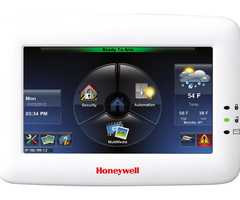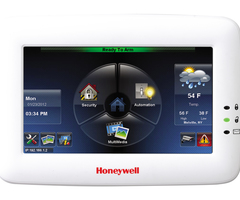Clearing a Latched Alarm Using a TuxedoTouch Keypad
Related Products


Related Categories
Description
In this video, Michael from Alarm Grid explains how to clear a latched alarm from a Honeywell VISTA System by using a Honeywell Tuxedo Touch Keypad. A latched alarm refers to an alarm that is "stuck". In other words, the alarm does not go away and clear as soon as you perform a system disarm. The reason why this happens is due to the "alarm memory" feature that Honeywell intentionally programmed into the system. The purpose of alarm memory is to make absolutely certain that you are made aware of any system alarm that occurred. Otherwise, you might return home, immediately disarm your system, and never know that an alarm took place.
When you go to clear a latched alarm on a Tuxedo Touch Keypad, the first thing you will want to do is get any keypads and sirens to stop sounding. This can be done by entering the system's Master Code, or any other valid user code. However, you will notice that upon entering the code into the Tuxedo Touch, the latched alarm will remain. You will need to pull up the faulted zone screen and clear the faulted zones. Again, this will require entering the Master Code or another valid user code. This process does not require entering Console Mode on the Tuxedo Touch Keypad.
You will know that the latched alarm has been cleared because you will get the green "Ready to Arm" message at the top of the Tuxedo Touch Keypad. It is also very important to remember that a latched alarm will not clear if the associated sensor for the zone is not restored. For example, if the alarm was caused by a smoke detector, then you must wait for the smoke to exit the detection chamber so that the smoke detector is not reporting a fault to the system. Likewise, if the alarm occurred due to a perimeter zone being faulted while the system was armed, then the contact sensor must be restored (aka, closed) so that the system is not receiving a fault from the associated zone.
https://www.alarmgrid.com/faq/how-do-i-clear-a-latched-alarm-using-a-tuxedo-touch-keypad
http://alrm.gd/get-monitored
Transcript
[MUSIC PLAYING] Hi, DIYers. This is Michael from Alarm Grid. And today, I'm going to show you how to clear a latched alarm from a Honeywell Vista System using a Tuxedo Touch keypad. Now, a latched alarm to put it into very simple terms, it's stuck in alarm mode. And you want to get it out of alarm mode. Normally, when you go and disarm a system, it clears the alarm. But the way that this system is designed, it has something called the alarm memory. So that way, when you get home, maybe an alarm occurred while you were away, and you didn't know about it. And you, the first thing you do would be immediately disarm the system. And then you potentially wouldn't know without the alarm. So Honeywell put in the feature called alarm memory to where you have to specifically acknowledge the alarm. Otherwise, it's not going to clear. So people will have an alarm on their system, and they'll go there to clear it. And they'll do the disarm. And they'll find that they're having trouble clearing the alarm. That's because of the alarm memory feature. The system wants to make sure that you know that the alarm happened, that you're aware of it. So it has this safety measure, so to speak, put into place to prevent you from not knowing about the alarm. You're going to know about the alarm. So you have to follow a specific process to clear it. And one thing that often confuses people, they think they have to go into console mode on their Tuxedo Touch. Console mode is having the Tuxedo act like an alphanumeric keypad. It's often used for programming. It's pretty useful. What's important to know about, what I'm going to show you here today, you do not have to go into console mode at all to clear a latched alarm on a Tuxedo Keypad. You can do this all without console mode. So I actually have two sensors set up with the vista system here. One is programmed as a perimeter zone. And the other one's programmed as a 24-hour fire zone. So I just want to show you the processes for clearing both alarm types. We don't have an actual smoke detector enrolled with the system. I just enrolled a contact and set it up as a 24-hour fire zone just for example purposes. But it'll be the same principle. So I'm just going to go through them one by one and show you how you would clear these alarms. I will start with the perimeter one. First time to arm the system, I'm just going to do it on this keypad here. And we entered in our-- we entered our-- --away. Exit now. We entered our master code plus two to arm away. So our system's armed away now. And I'm going to fault this perimeter zone right here. And it's going to trigger an alarm. [ALARM BLARING] OK. The first thing we want to do, we want to silence the alarm by entering a valid user code or the master code. [ALARM BLARING] There. We silenced the alarm by entering our master code, 1, 2, 3, 4. --not, ready to arm. You'll see that we get this clear message to clear the alarm. We're going to go ahead and do that. But this isn't going to wipe it out all the way. But I will enter in the master code. That's the first thing you'll do when you get an alarm. You're going to want to stop the sounding. It was annoying for everyone in this room. We wanted to stop it immediately. So we entered in a valid code. But if you'd see on the screen, it still says not ready. There's an alarm. We haven't cleared the alarm yet. So that's how you clear the latch part. We're going to show you that now. You see on the right here, it says faulted zones on the Tuxedo Keypad. We're going to click on that. And it's going to pull up the list. It was zone number nine that caused the alarm. That was our perimeter zone that caused the alarm. And one thing I want to make very clear, we're going to restore the. Zone so that way, the zone is restored. If you had a smoke detector and it was a fire alarm, you would have to get the smoke out of the chamber. If it was carbon monoxide sensor, you'd have to get CO out of the chamber. You have to clear the alarm, 24-hour zone contact sensor, put the sensor back to the magnet. We've restored the zone. So now that our zone is restored, I can press clear down here. And I'm going to enter in the master code again, 2, 3, 4. Remember, that's the default one. And we get the chime. And we're ready to arm. So we're good to go. Disarmed. Ready to arm. And the system confirms that for us. So now, I'm going to show you the same thing, but I'm going to do it with this 5816 that I've programmed as a fire zone. We have it right up here. And once I set this off, it's going to go into an immediate fire alarm. So here we go. [BEEPS] Fire, zone 10. You see that this time it says touch here to silent, which is it's the more or less the same thing that we just have to press this button to silence the alarm. Remember, we restored the zone. In this case, we put it back together, the sensor and the magnet here. If this were a smoke detector, you'd have to wait for the smoke detector to clear out. But in our case, we can do the clear button. It took us right to the screen we needed to. And we're just going to enter in our master code, 3, 4. [BEEPS] And sometimes it will require you to do it again, which is the case here. So we're going to just do it one more time, the faulted zones. And we're going to press clear at the bottom. And we're going to enter in our master code, 3, 4. [BEEPS] And now, we're ready to arm. The latched alarm has been cleared from the system. As you can see, it's pretty much the same process whether it's a burglary intrusion alarm or a fire alarm. But I just wanted to show the slight difference that touched to silent button that comes up. Either way, that's how you would clear the latched alarm. You make sure that the sensor is restored. And then you do that disarm. And then you have to go to that faulted zone section and clear them. The reason, again, it makes you do that, that's alarm memory. It really wants you to know that this system was in alarm. So that way, if you just came home, and immediately disarmed, and the alarm went away then, you might not ever know about it. So that's why they have that alarm memory feature. And you have to clear that latched alarm by clearing the faulted zones. So that's how you clear a latched alarm on a Tuxedo Touch Keypad for a Honeywell Vista System. If you found this video helpful, make sure to give it a thumbs up below to like the video. And remember to subscribe to our channel to get updates on future videos. And if you have any questions about the Tuxedo Touch, or about Honeywell Vista Systems, or alarm monitoring, shoot us an email at support@alarmgrid.com. Hope you enjoyed the video. Thank you.
- Uploaded
